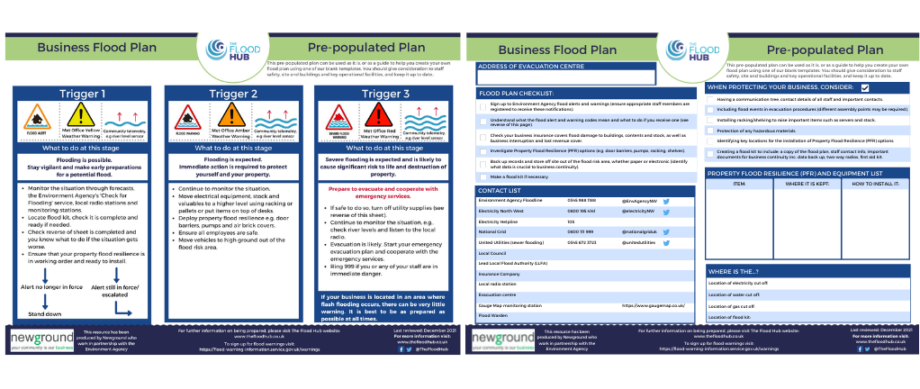This blog been written by a member of the Newground Flood Team.
In England and Wales approximately 185,000 businesses are located in flood risk areas; however many of them are not fully aware of their flood risk. Therefore becoming aware of your flood risk and planning and preparing for possible future flood events can have a massive benefit to many businesses.
With around half of all small businesses having no formal business plan or contingency plan in place, many will not be prepared to deal with a flood event. Most businesses without a contingency plan never recover from a disaster (even when insured), which is why if you own a business it is crucial that you check and learn about your flood risk and take the necessary steps to mitigate the threat. You can check your flood risk online here: https://flood-warning-information.service.gov.uk/long-term-flood-risk.
To plan for flooding effectively you first need to know and understand your flood risk, taking into consideration multiple sources of flooding as well as their likelihoods and the severity of expected events; in particular the depth and duration of flood water. Developing a good flood plan can quite easily be the difference between your business recovering or failing as a result of a flood event.
When developing your business flood plan, consider the impact of a flood event on the key aspects of your organisation. Flood planning is not all about responding to an actual event, it’s equally as much about making the decisions and changes to the way you operate beforehand and planning to reduce the impact. For example:
- Your staff. You have a duty to ensure their safety and wellbeing. Arrangements should be made to assist staff members who would need help in an evacuation, as well as making provisions for staff to move their cars and leave work safely.
- Your building and facilities. If your premises are rented, you may be reliant on your landlord’s timescales for reinstatement work before you can return to the premises and trade. Try and mitigate this by making provisions for either temporary working arrangements at your current site or moving operations to alternative premises during this period.
- Equipment and stock. If, for example, your business is in manufacturing or fabrication, some of the machinery and equipment you rely on may not be quickly sourced or easily repaired. Hopefully, you’ll already have a contingency measure in place for this, but where possible consider raising machines, equipment and stock or physically protecting them via internal flood barriers or walls.
- Supply chain. Source multiple suppliers and consider holding a buffer stock of both raw materials and produce where feasible. Consider alternative locations which can be used at short notice to hold deliveries as well as adopting purchase and supply agreements for missed deliveries or unfulfilled contracts.
- Business continuity. Ensuring all of your data is backed-up automatically at the end of each day to an off-site server or one located somewhere out of flood risk is strongly advised. If your server room is located on the ground floor and cannot be moved, consider the use of property level resistance measures to protect your offices.
Business Flood Planning Tips
- Make sure your business has insurance cover in the event of a flood – see our Business Flood Insurance resource here for more information. While this can be expensive, there are ways in which you could reduce the premium or excess paid under a policy.
- Remember to take photographs of buildings, equipment, machinery and stock now and before a flood event occurs. Having a detailed procedure in place covering the steps you need to take when you first return to the business premises can help to ensure the site is safe and damage is photographed and documented before staff return or anything is either moved or disposed of.
- If sewage is present, contact your water company who will come and carry out a preliminary clean.
- If you use, produce or store any hazardous chemicals onsite which would be at risk of mixing with floodwater and contaminating the wider area, it is important that the flood warning trigger you use allows enough lead time to make the necessary provisions with regard to chemicals and hazardous waste.
- Investigate property flood resilience measures and incorporate the deployment of these measures into your flood plan, highlighting the locations of where they are stored and installation instructions. Having such measures in place could help to prevent your site or building from flooding altogether and make the clean-up and recovery process far quicker if it does. You can find out more about protecting your property by downloading this ‘Property Flood Resilience (PFR) booklet’ from The Flood Hub here.
- When writing your business flood plan, record the details of the designated flood wardens along with their roles and responsibilities. Create a flood kit containing a register for staff members and a list of key contacts (staff, suppliers, customers, agencies and insurance company details), as well as two way radios, hi-visibility vests, gloves, wellingtons and any other equipment that may be needed. Identify a suitable trigger point for actioning your flood plan and record the steps which must be taken at each stage. Make staff familiar with the key points of the plan and ensure it is kept up to date and incorporate this into the induction for any new staff that start.
- Finally, in much the same way you would undertake a fire drill, practice dry-runs and test your flood plan.
To help get you started with developing a business flood plan, you can download a business flood planning guidance booklet here.

You can download a business flood plan template here.